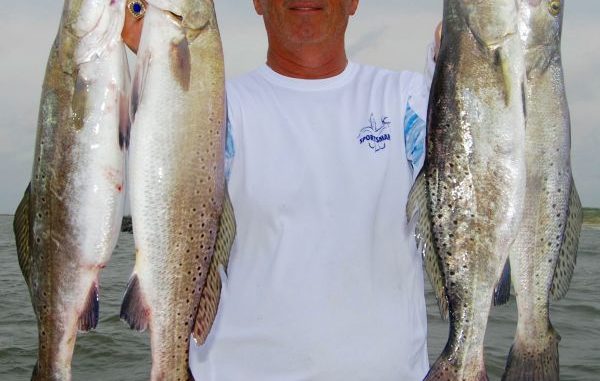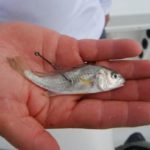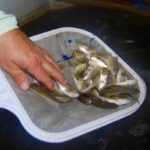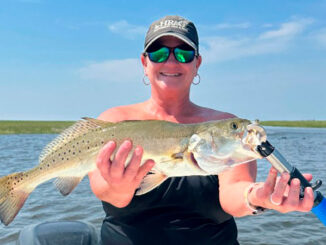
A beginner’s guide to free-lining croakers to catch specks on Grand Isle
I’ve had the opportunity to catch speckled trout any number of ways: under a popping cork, on plastic paddle-tail lures and artificial shrimp, throwing topwaters and jerkbaits and on Carolina and drop-shot rigs outfitted with live shrimp — but never, ever by free-lining live croakers.
So when Tommy “Carl” Vidrine texted me last week with an unexpected invitation to join him Thursday morning on Grand Isle with his 24-foot NauticStar’s livewell full of croakers from Bridge Side Marina, I jumped at the chance.
And boy, am I glad I did.
In about two hours of non-stop action at the southern point of the Caminada Pass jetties, we caught 50 hammer trout that ranged from about 2 3/4 pounds to a couple just over 5, with the vast majority of the fish solidly in the 18- to 20-inch range.
And we literally left them biting.
“It’s really pretty simple fishing.” said Vidrine, an independent contractor for Aflac who lives in Baton Rouge and loves targeting big specks around Grand Isle. “Some people think it’s hard, but it’s not — if you’re patient during the bite and don’t jerk the croaker out of their mouths too soon.
“That’s the hardest part for people doing it for the first time.”
The trout were stacked up in the submerged rocks at the end of the jetty, and you could feel tension on the line as the croakers — hooked through the back — swam down after each cast and then eventually encountered a speck. The inevitable rod-yanking thump followed — but allowing the trout to swim off for 5 feet or sometimes more before setting the hook — meant we didn’t miss many fish all morning long.
“Let the croaker do all the work,” Vidrine said. “Free-lining with live shrimp is more difficult because the current pushes it around. The croaker’s got more weight, I can throw it further and I don’t have to do much – just tighten up and have fun.
“When the croaker hits the water, he swims down right into the danger zone where the trout are waiting.”
Here are Vidrine’s top 5 tips to catch speckled trout with live croakers:
1. Get quality bait
Most of the croakers we used Thursday were in the 3- to 4-inch range — the perfect size for trout to inhale them in one bite. They’re available at Bridge Side Marina for 30 cents a piece.
“Little-bitty ones die fast when you stick them with a big hook, so the bigger they are the better,” Vidrine said. “They have more action and they stay lively longer. The more they move and quiver, it frustrates the trout. They can’t stand it.”
Run the aerator and recirculator in your livewell to keep them healthy as long as possible, and Vidrine said to make sure your hands are free of bug spray, soap, cologne, perfume and sunscreen when you reach in to grab one.
“That happens to a lot of people and they just don’t think about it,” he said. “If you look in the livewell and see those croakers barely moving, they’ve probably been poisoned.”
The quality of the live bait at Bridge Side is fantastic, Vidrine said.
“Buggie (Vegas) does such a good job with those fish. Their filtering system for the water is outstanding,” Vidrine said. “”It’s like a swimming pool, with filter sand. The water is really clean. They’re not selling any beat up croakers.”
2. Use a No. 3 kahle hook
Vidrine favors a No. 2 circle hook when he free-lines live shrimp, but likes a larger hook when he’s using croakers to make sure the hook’s barb finds the trout’s mouth.
“I think the No. 3 kahle hook is the best hook for croakers, because when you set the hook, they have all that meat in their mouth,” he said. “If you get too small on the hook with a good-sized croaker, the hook won’t set.”
(And the hook is the only thing attached to the end of his 14-pound mono line: no split shot, weights, clips, swivels, etc.)
3. Hook the croaker through the back – just above the mid-line
This is key for a couple of reasons, but mainly because Vidrine likes the fluttering action created by the croaker struggling to move with the hook in its back.
“It makes them quiver in one spot. If you put the hook through their lips, they kind of swim normally,” he said. “A trout is such a predator, he can’t stand that wounded movement.
“I compare them to a lion. If a lion sees a wounded gazelle — even if he’s not hungry — he’s probably not going to pass up an easy meal. It’s the same thing with trout. Their instinct is to attack — they just can’t resist.”
Just be sure your hook is far enough down in the fish so it won’t tear off when you cast.
“Hook it deep enough so when you give it a long cast he’s not going to fly off,” Vidrine said.
4. Be patient with the hookset
When the trout are absolutely slamming the croakers like they were on Thursday, it’s sometimes hard not to react immediately with a strong hookset. But patience is key, Vidrine said.
“Right now the croakers are smaller, so they pretty much put the whole thing right in their mouths,” he said. “The trout don’t have to strike it a few times to kill it. But when the croakers get bigger later in the season, you have to let them take it deep into their gullet before you set the hook because it’s a lot of meat.
“Even if the trout is running sideways with it, you let him go until he’s sucked it in all the way and wants to swallow it. Then when you set the hook, their mouth is closed all the way, the fish is all the way in and you’ll hook them.”
5. Don’t use braided line
Vidrine prefers 14-pound monofilament line because it allows the croakers to move so naturally in the water.
“They don’t see that line. Big fish are big for a reason, and they see that braid, I promise you,” said Vidrine, who typically uses green Trilene mono. “If you do use braid, make sure you’ve got a 4- or 5-foot mono leader. I like the green because it looks like the green water.
“It doesn’t show a lot.”
Hopefully these tips will help you to land some big specks with live croakers. And if early season action is any indication, Vidrine said the next six to eight weeks could be really special at Grand Isle.
“Croaker fishing is just going to get better for about the next two months,” he said. “I think croaker is the bait of choice.
“If you want to slam some fish and you’re a serious fisherman, buy the croakers.”





